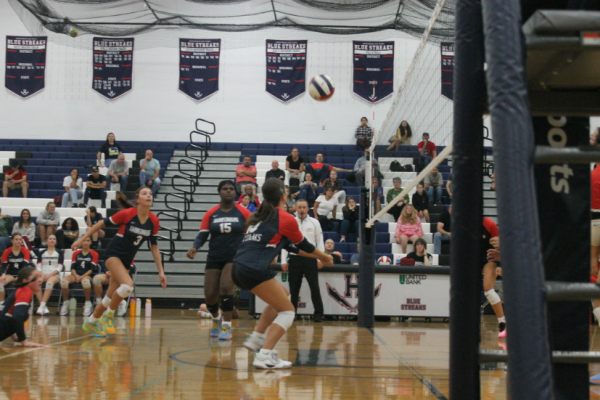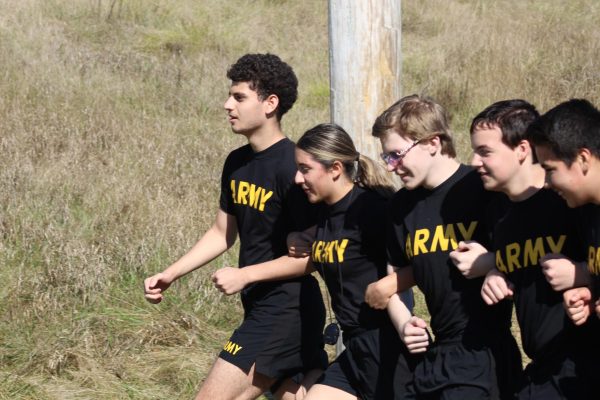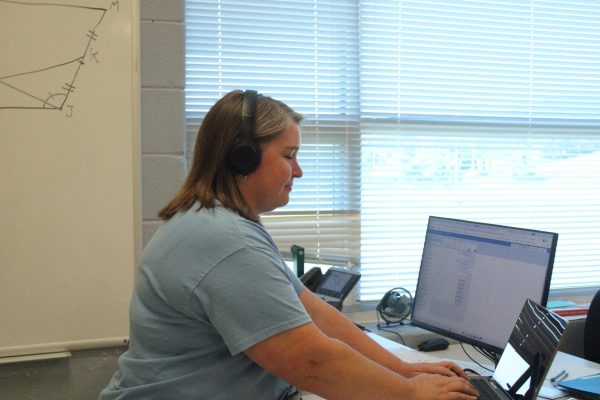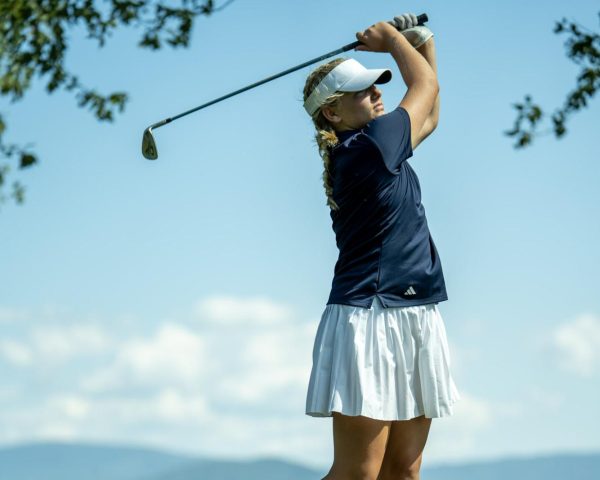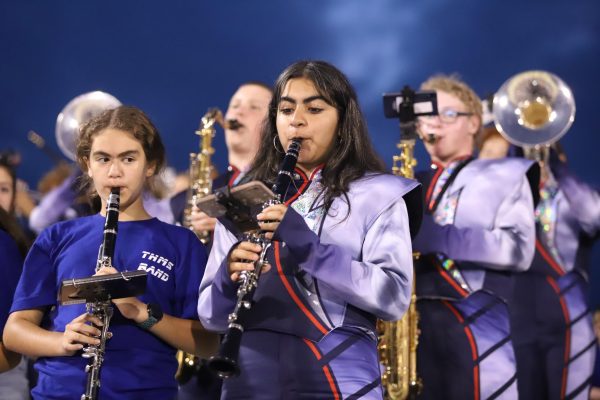Hensley addresses difficulties, successes following Quarter 1, looks to future possibilities
(Photo taken March 17, 2020) Principal Melissa Hensley assists with meal distribution to families. Since lockdown began, bagged meals have been provided for Harrisonburg City Public Schools students. “Meal distribution continues to go really well. Lots of folks [are] coming out for that on a daily basis,” Hensley said. “[I’m] glad to see the community and students taking advantage of that. I’m [also glad] we’re able to provide it and that folks are able to get out here to access [it].”
In her second year at Harrisonburg High School, Principal Melissa Hensley had to pivot from managing an overcrowded school building to administering nearly 1,900 students spread across the city from her computer. As the majority of students are enrolled in virtual classes during the first semester, Hensley has encountered both expected and unexpected challenges.
“We expected students and staff to have some challenges adjusting to using Canvas, the new LMS (learning management system), and to working from home,” Hensley said. “[Students have] new classes and new teachers who they didn’t have a relationship with unlike last spring when we parted ways and students at least had a relationship with [their] teachers face to face.”
While Hensley expected there would likely be difficulty fostering student-teacher connections, she did not expect the increase in the number of students that are struggling academically.
“I think sometimes we make the assumption that young adults are very tech-savvy and prefer a computer screen, [but] in fact, I think that’s many times not the case,” Hensley said. “Many would prefer to be on site, and I think it’s been quite a challenge for some of our students to learn in the way we’re asking them to learn.”
Because adjusting to this new learning format has been challenging for a portion of the student body, HHS has experienced a higher failure rate following Quarter 1 compared to last year’s statistics.
“Our failure rate is a little bit higher than it was when we were face-to-face at this time of the year [last year], and we need to provide more support and opportunities for students to get some more face-to-face help if at all possible somewhere down the road,” Hensley said.
Hensley is currently planning to offer this in-person support through the HHS Access Center. The space currently functions as “a quiet place to access internet to complete schoolwork,” but she hopes to utilize it differently by offering students individualized tutoring and assistance.
“We’re laying some tentative plans for [using the Access Center differently] right now, and we’ll be prepared to roll that out in the next couple of weeks to students, particularly [to] those who are struggling the most,” Hensley said. “We’ll be able to do some things [like offering] some tutorial opportunities from someone who can actually teach content [students are learning]. We’re hoping that students will take advantage of that and that it will help.”
While Hensley expected there to be difficulty for students to make connections with their teachers through a virtual format, she has also struggled with forming relationships with students herself.
“Learning the culture and the environment [of HHS] and really getting to know people was something that I was really focused on last year. When there’s nobody here, it makes [doing] that very difficult,” Hensley said. “I don’t see people walking down the hallway [and] have informal conversations or connections with them. It’s definitely been more challenging, but I still think I have enough administrative experience to be able to carry this piece of it. It’s just very challenging and hard to really get to know HHS and make sure it’s thriving.”
Staff Community and Blue Streaks’ Beat
Not only has there been an absence of informal conversations and connections between faculty and students, but these interactions have also minimized among staff members themselves.
“It’s hard [to retain a staff community because] we don’t have as much of the informal conversations, which I think are really important,” Hensley said. “That part [we] just don’t get, like seeing someone at lunch and saying, ‘Hey, how are you?’ [We don’t get] those really informal check-ins, and that’s something I really miss.”
However, Hensley and other faculty have found ways to show HHS staff that their work is appreciated.
“Earlier in the year, we [sent] out some gift cards and things to our [teachers] to thank them for the work that they’re doing. There’s [also] some letters and cards being sent out by various groups in the building and administrators; [they are] random acts of kindness, if you will. [We’re] encouraging others to send cards out to say, ‘Hey, thank you for what you’re doing,’” Hensley said. “We are still a community; we are still the Blue Streaks. [We’re trying] to maintain that connection as much as we can outside of just having meetings or popping into classrooms online.”
In addition to the random acts of kindness, administrators have found a way to create dialogue and connections among faculty members while also addressing an important social issue relevant to HHS. This is done through a group called Blue Streaks’ Beat.
“It’s actually a group right now that meets on a voluntary basis, but we get between 35 and probably 75 teachers and staff members a week [to participate]. Our focus is on, right now, building an anti-racist environment from an educator’s standpoint and perspective. We’re hoping to pull some students into that group, as well,” Hensley said. “Even though it seems like work, it’s really the dialogue and things that are taking place that are allowing us to build a community and to have conversations be really good and rich around a topic that is of high interest. Because of this, people are volunteering that want to be a part of that conversation.”
The group members part of Blue Streaks’ Beat are completing three modules developed by the Kirwan Institute for the Study of Race and Ethnicity to learn about implicit bias. They are also using the equity handbook from the Virginia Department of Education to analyze the culture at Harrisonburg High School.
“[We] check off the different categories where we feel like we’re doing well and the ones that we feel like we’re struggling with right now. We’re using [the handbook] to really look at what we have and what we don’t have [in order to find] where we need to make changes so that we can create an action plan,” Hensley said. “What we really want to do after we finish these three modules is to invite some students to get some student perspectives on that group. It’s a group that’s really passionate about exploring these topics.”
On-Site Activities
Though most students are learning remotely, there is a select group of students attending school on-site. This includes special education and English-Language Learner students. Hensley is proud of the work the students and teachers on-site have accomplished.
“The teachers are providing good instruction and building relationships with students that are on-site. Clearly, the students enjoy being here and seeing each other again. Some have just not had as much contact with others with [access] to phones and things of that nature,” Hensley said. “Students are really taking opportunities to get out of [school] what they need for themselves. I think that’s a really important component of it.”
In addition to some education occurring in the building, certain extracurricular activities have also routinely been taking place on-site, like athletics and marching band practices and musical rehearsals.
“We’ve had small groups here in a variety of different capacities, and I’m excited they’ve had the opportunities to continue to build community and make those connections,” Hensley said. “I think that’s as important as the learning activities are. We still need to have those relationships with others around us.”
While at first only very few activities were permitted to take place on-site, more extracurriculars have been allowed to move forward at HHS due to students diligently following safety protocols and social distancing guidelines, like the musical.
“We were confident that the musical was something we could expand into [at HHS] based off of the success of those [in other on-site activities] before them,” Hensley said. “There are things going on here that are really positive and good, and I feel good about where we are right now.”
Athletics
While athletes have been participating in preseason workouts ahead of the Virginia High School League’s (VHSL) Dec. 7 start date for official practices, the Harrisonburg school division has made no decision about whether HHS will participate in winter sports. However, should Superintendent Dr. Michael Richards and other district administrators make the decision to proceed with sports, Hensley, Athletic Director Brandon Burley, Richards, Chief Operating Officer Craig MacKail and Chief Academic Officer Pat Lintner have a plan in place for how this will occur.
“We have been working very diligently. [The plan] looks different for indoor sports and outdoor sports, as would be expected, [but] we do have a really good plan in place,” Hensley said. “We’re still making some tweaks and modifications to that based on the CDC (Centers for Disease Control and Prevention), Virginia Department of Health and VHSL recommendations, and we’re aligning [them] based on our school division’s beliefs and practices at this time as well. We need to continue to monitor things and make a good decision for everyone based on if we feel we can safely play or not.”
The Dec. 7 date that practices are slated to begin is in a few weeks, so Hensley believes that the decision whether or not to play winter sports will be made soon.
“At the last school board meeting, there was a presentation about athletics to the school board members, so they’ve had the opportunity to ask questions and provide comments. At that point, Dr. Richards [noted] he was not asking them for a vote, and this would be a decision made among district administrators. Unless something changes, he’ll continue forward with that,” Hensley said. “Mr. Burley and I do have a meeting again scheduled next week with Central Office staff to further discuss what we feel like we need to do at this point as we’re quickly approaching Dec. 7.”
The plan Hensley and her colleagues have formulated has required numerous adjustments and considerations based on both COVID-19 statistics and athletics arrangements in surrounding areas.
“[The plan is] based on the growth of the numbers and where we are holistically as a country, where we are in the Commonwealth [of Virginia] and where we are in Harrisonburg city. I think that’s a big piece for us, but we also have to take into consideration those that are around us,” Hensley said. “If we were to play, we would be traveling outside of Harrisonburg city. Where would we be going? What are the numbers like in those areas? What safety protocol have they put in place in those areas?”
Despite the numerous concerns that have to be taken into account, Hensley believes that if winter sports do occur, the current plan puts HHS in a good place for athletics to run smoothly.
“I’m very comfortable with the plan Harrisonburg City Public Schools and Harrisonburg High School has developed in conjunction with [guidelines] that have been provided by the National Federation…, the VHSL, the CDC and the Virginia Department of Health,” Hensley said. “I think we’re in a really good place with our plans.”
Looking Ahead
In a letter sent to HCPS families Nov. 9, Richards informed the community that the school board will be waiting until the second semester before considering increasing in-person learning across all schools in the division. Since how HHS will be learning in the near future is up in the air, Hensley and HHS administrators have began planning for the potential of both continued remote learning and in-person learning.
“As we continue at Harrisonburg High School to plan for the second semester, we’re starting to look at both [learning] models. What are we doing if we are purely remote learning? Are we staying in the same model we’re in? We’re also planning for any hybrid models that could come into play down the road as well,” Hensley said. “For my leadership piece and my team, we’re just preparing for a multitude of different options that may come down the pipeline so that we’re ready. Regardless of what happens, we’re ready to make that happen for our students and staff.”
Though much remains undecided about the future of HHS learning and activities, Hensley encourages students and their families to both stay safe and to reach out.
“If anyone has an idea they think would be really great, please continue to share. It helps us to really think through processes and meet needs,” Hensley said. “It’s very hard to have your hand on the pulse of what’s happening when everything’s so spread out. Please reach out and communicate if you have ideas or things you’d like to see be done differently or if we can be of help in a different way.”
Your donation will support the student journalists of Harrisonburg High School. Your contribution will allow us to purchase equipment and cover our annual website hosting costs.



![(Photo taken March 17, 2020) Principal Melissa Hensley assists with meal distribution to families. Since lockdown began, bagged meals have been provided for Harrisonburg City Public Schools students. "Meal distribution continues to go really well. Lots of folks [are] coming out for that on a daily basis," Hensley said. "[I’m] glad to see the community and students taking advantage of that. I’m [also glad] we’re able to provide it and that folks are able to get out here to access [it]."](https://hhsmedia.com/wp-content/uploads/2020/11/287A1153-900x600.jpg)
